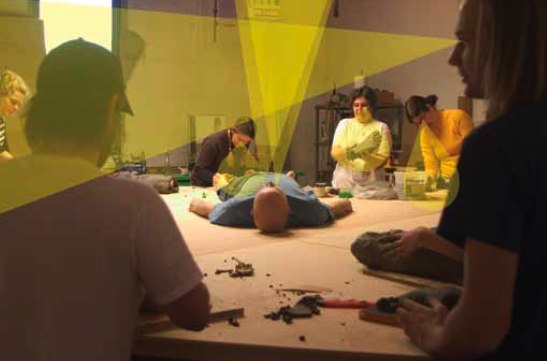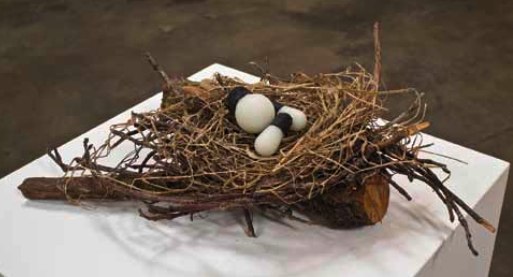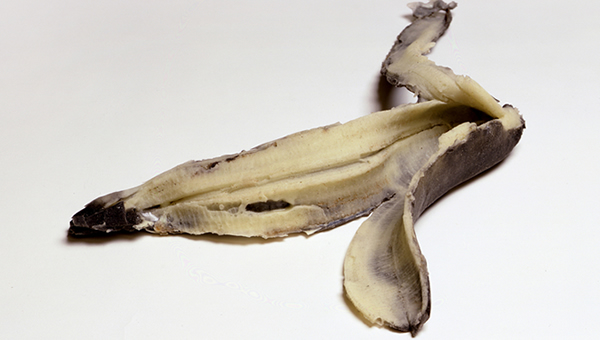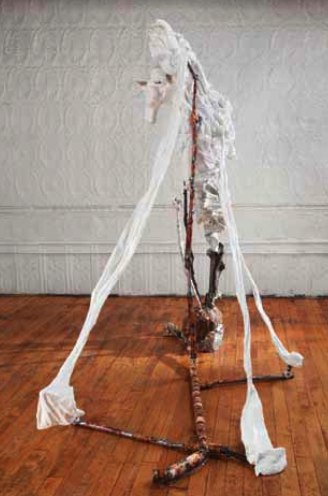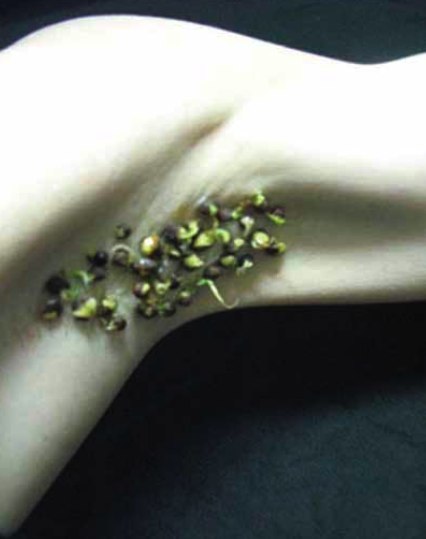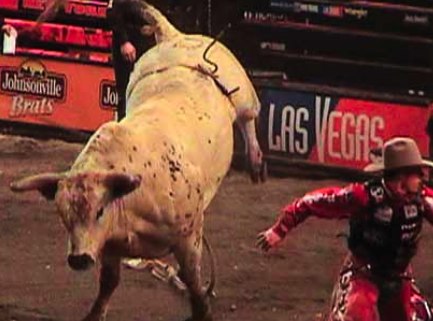video<>object
video<>object is a show curated by Laurence Hegarty for Romanov Grave.
It presents the work of five artists: Nancy Davidson, Yasue Maetake, Halsey Rodman, Jeanne Silverthorne and Moira Williams.
The show was presented at the Dorsky Gallery Curatorial Program located at 11-03 45th Ave, Long Island City, NY 11101, 718.937.6317.
Download a pdf of the catalog: DorskyShow
video<>object – essay
“Television is a rehearsal for the time when human beings will no longer need to have bodies.” — Vito Acconci
If one wants to think about the history of video art, Rosalind Krauss is hard to ignore. Her seminal essay “Video and Narcissism”-an inaugural essay for the journal October no less-characterized the practice of Video Art and its object as the narcissistic look of the artist toward his (as was mostly the case) self. Invoking what we would now think of as the ‘early work’ of Vito Acconci and Peter Campus, Krauss noted that video’s “real medium is a psychological situation, the very terms of which are to withdraw attention from an external object-an Other-and invest it in the Self”. She went on to define the ‘psychological situation’ as one of near pathology and, as her title presages, ‘narcissism’ was the characteristic condition of video art.
The artists in Video<>Object have all dallied in their transactions between video and sculpture, with bodies and their absence and indeed with glances at the self. Now, I would quickly add, it could be somebody else’s Self-a.k.a., an Other-as with Nancy Davidson’s scrutiny of the rodeo cowboy. Or it could be something like the outsourcing of a body as with Halsey Rodman. Rodman has pondered questions of how a self is constituted in and by the looks, exchanges and actions of others; specifically, twelve others in his piece, The Navigator.
Rodman assigned twelve collaborators, as if in BFA Sculpture 101, the task of sculpting a likeness of Rodman himself in clay. Each of the twelve produced a clay rendering of him or some part thereof. One year later the procedure was repeated. On both occasions the process was videotaped. The resulting sculptures themselves, i.e. The Navigators, have, ironically enough, been unable to find their way back to New York for the Video<>Object show and thus Rodman has responded to their loss, demise or flight as the catalyst for a new piece of work. He has made a sculpture in response to the missing Navigators. This time, using again the clay modeling techniques of Sculpture 101, he has rendered the negative space that The Navigator no longer occupies. There is much rumination and dialogue here about the loss, recovery, and re-loss of a self and its body. There is an implicit dialogue with Krauss and with Acconci too, but one cannot help but also be struck by the repeatedly chosen material and the resonant histories that it-clay- has. Bodies formed with clay? It is Promethean for sure but it is also the Golem, the mythic figure modeled from clay and brought to life to protect the Jews of Prague from the coming pogrom. The Golem is, of course, the dissociated rage of the victim retaliating. It is a feared power that if lost control of-as it is in the original myth and in Mary Shelley’s rerun-can bring destruction upon one’s self or community. So the question arises: If one is to have a self, what are the acceptable components of that self? And, can we outsource, or indeed, otherize the parts we don’t want?
Jeanne Silverthorne has long had a practice where the studio stands as the laboratory for rendering selves. Historically, hers has been a Frankenstein-like endeavor where scraps of clay, scavenged from the studio floor, are fused together to model homunculi figures that pose a contrarian’s version of narcissism. All these globby, hybrid mutations of sculpture and biology are set to be zapped with the vivifying force of electricity were it not for connections through fake rubberized wires, fake rubber outlets and often as not, termination at a mute lifeless rubber light bulb.
In more recent work, she has honed the sculptor’s craft to produce in miniature finely crafted figures of friends, self, family members and more. Deferring the coy enticement of Hummel figurines, these diminutive sculptures instead stand as an army of alienated dwarfs who, at their most compelling, glow in the dark through the alchemical whimsy of phosphorescence. In Video<>Object, Silverthorne shows a video of herself-shot close, artist’s hand at work imbuing the inanimate with the appearance of life- sculpting one such figure: Bob. Bob, this Bob, this voodoo, hoodoo figure is an image of the artist’s husband, Bob. It has been said before that to sculpt is to inevitably invoke the Golem. Perhaps all of sculpture, from the Contrapposto and The Laocoön, with their drive to imbue inanimate has invoked this mythic act. If so, what lack of knowledge or courage deprives us the sonorous tone of Silverthorne leading the artists in Video<>Object as they incant the final spell to bring actual un-life into the gallery?
Well, I think the answer is that Silverthorne is more concerned with the failure of such hubris. The very clumsiness of her early homunculi figures, the failure of all that circuitry to deliver anything points us closer to Stan Laurel than to God. And here, in Video<>Object, note the wall, the flock of houseflies. Note the quoted video from the film The Fly, of flies hovering around an overflowing trashcan; remember man turned into a fly through the vanity of science. Note, too, the quoted video from the film Fitzcaraldo, a film about insane hubris if ever there was one. Note the banana peel across the floor there on the low podium. And, addressing the wall of framed video monitors are the floor-bound sculptures of fans. Rubberized again, these eager little machines spin on and on and on cooling nothing, moving little, bleating not, even though we might expect them to. Perhaps Silverthorne’s interest here is less with the ecstatic invocation of godly power and more with the ecstasy of the witnessed pratfall. We laugh, says Freud, because the joke produces pleasure “by lifting suppression and repression.” In other words, we camouflage our dissociated aggression in the joke-the banana peel-and do not court losing control of it in our own progeny, the Golem.
In a related vein, Yasue Maetake’s work invokes animist ritual, alchemical procedures, and, in no small part, the black arts. In her video, Parthenogenesis, elaborate ceremonies enacted in basements or in the woods, sometimes at night and seemingly secretly, coax a mute figure toward something like life. Via a multi-screen presentation Maetake offers a tri-fold juxtaposition of unfolding events that evolve toward a synthetic self. Prominently in this sequence of images, a limp female figure, bound to an armature, is incorporated within a hand-sculpted structure that ends by resembling nothing so much as a Rococo hairpiece.
Birth rites, death rites, regression and usurpation are all conflated by this magical, pastoral invocation of Marie Antoinette in the woods. The sense of bodies formed and perhaps merged and unmerged pervades. In Maetake’s own words the possibility is courted of “inanimate matter emitting ghosts, spirits, and human personae.” Selves are crawling out of the woods if not the woodwork. And that title: Parthenogenesis? Parthenogenesis itself is a form of asexual reproduction where growth and development of embryos occur without fertilization by a male. So the boys are not needed? And if not, do we sense that secrecy is? Hmm? To ward off the masculine and that aforementioned rage? Remember that the tale of the Golem is a very male affair: a species of male parthenogenesis, if you will. Maetake retains some of the Gothic shadows of Prague (and of Mary Shelley come to that) in her basement shots, but in a more sustained manner she embraces the pastoral as her mad scientist laboratory. If in her work the countryside feels like both a hideout and a raw material, it is also the place scoured for actual raw materials to draw back to the studio to be transmuted by the artist-alchemist. Thus, in If I were a Master Stone Carver, Maetake’s sculpture in the present exhibition, she treats all substances uniformly as the stuff of sculpting. There are many materials that bear the code-mark of nature: animal bone, hedgehog needles, crab shell, clay and fur. But there are also those coded in the domain of human culture: photographs, industrial construction processes, even petro-chemical products. All become the transmutable materials shaped around a skeletal framework to become the surrogate in the room. It is the body that, Acconci has offered, we will soon no longer need. But importantly, we’re not there yet. Let them eat bread! Sounds familiar, right? Moira Williams, in her performance and video work, takes the alchemical agent to be herself. In an ongoing series of works, titled Exchange and Dirt Shirt, Williams uses her armpit as the agricultural node whereat she germinates wheat seeds. Transplanted from this original site, the seeds are nursed along or cultivated in a shirt worn by the artist. The shirt is something of an exquisite corpse affair: a man’s white dress cum business shirt that has been amended to contain compartments filled with soil in which the seeds are nourished by water taken from public water sources. Next, the seedlings are transplanted to public land where they are brought to maturity by the artist. The plants are finally harvested and are used by Williams to bake bread. Guerilla agriculture, to be sure.
Toiling, or tilling, at the limits of the body, literally in the pits, Williams husbands the body to be transmogrified, if not transubstantiated, as the site for producing its own sustenance. Clearly, this body does not need Archer Daniels Midland nor the circuits of exchange that sustain corporate culture and define human economic and social relations. And it must be said that it all has a wonderfully autonomous, post-apocalyptic utility. The work is also a useful cipher for a collapse of narcissism. Aesthetically, the latter must be identified through its codes of expression. Certainly, this is where Krauss locates it: in the held glance toward the figure of the self. Williams’ video contains an opening shot that encodes an expectation of feminine seduction or narcissism-the hand raised as she looks toward the viewer or a mirror to run hand through hair-which shatteringly shifts to bare, beneath and to the side of said enactment, an unrecognizable stain. It needs to be said that it is truly hard to figure out what you are seeing at first under Williams’ arm. And thus codes are broken here (in the sense of “trashed” not “deciphered.”)
Cinematic codes to be sure, but also codes of production and consumption, codes of dependence and hierarchy. There is an undoing of conventions of how the body sustains and endures. It is also an antithesis of Halsey Rodman’s making of the self as an other. Rather, Williams absorbs and incorporates whole categories of otherness. Categories as fundamental as animal, vegetable, mineral are shifted as Williams claims them all to herself.
There is a risk with Williams that the work morphs her, the artist, into the monstrous figure; the self-feeding, self-regenerating beast that ate itself. Yet it feels more like resistance: political resistance not psychoanalytical. It is a way of representing a self outside circuits of exchange and authority.
Nancy Davidson’s recent work has drawn her toward a relentlessly mythologized iconography of America: The West. Davidson travels to Texas, haunts the rodeo circuit, films the tortured bulls flipping the boys and back in New York, edits the whole shebang down to just that repeated moment again and again: the sartorially amid the rodeo-clowns and the huge animals franticallly kicking and bucking.
But what then is this frilly confection-The Cowboy? Wild West shows of the nineteenth century saw some of the first translations of the role of the working ranch hand into the cultural spectacle of the cowboy taming the west. Rodeos were frequently combined with Wild West shows wherein, alongside the shooting competitions and horse roping, battle scenes were reenacted in excitable historical tableaux. Hollywood gets a special prize for filling out the details over the first five decades of the following century before a revisionist strain of The Western sought to at least struggle with questions of racism and genocide. The cowboy persona comes through this obfuscating filter as the agent of history who, flawed though he may have been, was the vanguard of the civilizing force of European-American expansion. And it is notoriously-though not uniquely-a history tale where the savagery of the colonizer is dissociated and projected upon the native. And here we have Davidson’s video. No horse opera or ballet, but shitty-assed bulls whose genitals are (or are not, depending upon your source of information) cinched tightly with a ‘flank strap’ to ensure that they buck. Synecdoche as it is for the conquest of The West, its land, and its inhabitants, the scene-man dominating bull-has an archetypal tang to it. A bull copulating with a woman is at the source of the Minotaur myth. A man, Theseus, struggling with the monstrous progeny is at its conclusion. And he, Theseus, who slew the Minotaur, was the founder king of Athens. And there could be no more deft honor-by-association for the cowboy than with the birth of European civilization. But-a very big but-the monstrous progeny, half bull/ half man, can only be contained by the labyrinth. Here the dissociated violence of the European expansion west can only be contained by the ideological labyrinth of history and popular spectacle.
The Wild West show. The Rodeo. It is all a narrative of great hubris, of power, conquest and selfaggrandizement. Primary Narcissism was, with Freud, a totalizing and indeed, imperialistic, figure: it is all me and mine, ‘there shall be no others’ insists the infant psyche. So what happens to such claim when it is recited and re-recited over and over? The conventional answer is that it is emptied of meaning. The re-said becomes like the obsessively repeated vocalization of the insane: the words fail to signal what they otherwise might have. But there is also the effect that Davidson’s repetition has; it destabilizes the sign of masculinity. It is, after all, ridiculously unnecessary for the dandified cowboy to tame a 1,000 lb. bull that does not need to be tamed. Bull riding thus appears as a prelapsarian delusion: a brief 8-second moment of triumph before your ass is dumped in the mud.
The artists in Video<>Object do not so much undo the defining narcissism of video art that so vexed Krauss, but they do tend to reframe it. Narcissism, in a torqued return of the look, is scrutinized by these artists through oblique glances. And in this there is a fluid drifting back and forth across the porous boundaries of self and other: Rodman outsources his self while Williams incorporates agriculture as part of herself. Davidson travesties the conceits of what we might call a cultural, historical narcissism of America’s myth of itself, while Mataeke works to conjure, in a Thoreau-esque pastorale no less, others from selves and selves from others. The canny take of Silverthorne is to sculpt herself into a corner surrounded by the shards of culture that have done the work of myth-making and self-making in tandem. I suppose I am thinking back to the video fragment she quotes from Godard’s Alphaville. A dangling bare light bulb that Godard, in turn, quotes from ten thousand films noir; the group of films that so luxuriously hid the self in the shadows of a culture aimlessly spinning out of its own orbit. I am paraphrasing someone, alas I remember not who, but he opined that film noir was culture “on the cusp of autism.” Perhaps then this is what we can say about the artists in Video<>Object. They are engaged in a duel between the giddy pleasure in the self and the impossibility of saying this is not me. They are troubled by the possibility of falling silent around the recognition that language-culture really-is not an address to the self but a call to others.
– Fintan Boyle
New York, 2011
